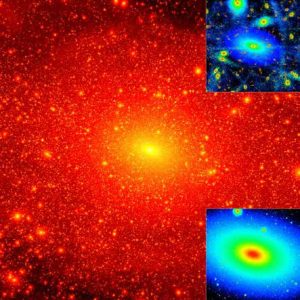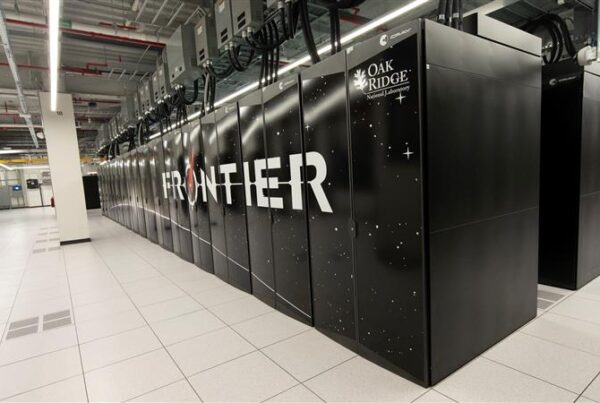In 2017, the Oak Ridge Leadership Computing Facility celebrated 25 years of leadership in high-performance computing. This article is part of a series summarizing a dozen significant contributions to science enabled by OLCF resources. The full report is available here.
In 2007, researchers shone a galactic-sized light on the dark matter that holds our galaxy together by performing a large-scale simulation.
Using the Cray XT4 Jaguar supercomputer, a team led by astrophysicist Piero Madau of the University of California, Santa Cruz carried out the largest simulation to date of the Milky Way’s dark matter—the invisible material that provides most of the universe’s mass—and its evolution over 13 billion years. The work revealed new details regarding the likely distribution of the invisible substance throughout the galaxy, especially in the Milky Way’s dense inner reaches, and gave astronomers a valuable tool in their search for dark matter.
As ongoing experiments and high-powered telescopes, such as NASA’s Fermi Gamma-ray Space Telescope, continue to search the universe to increase understanding of dark matter, large-scale simulation could provide the critical information that tells scientists what to look for.
The Science

A cube of 800 kiloparsecs (kpc) per side is shown. The insets focus on an inner cube of 40 kpc per side (outlined in white), and show local density (bottom inset) and local phase-space density (top inset).
Since the 1930s, scientists have realized that visible matter supplies far too little gravitational force to explain the observed orbits of stars and galaxies. To account for the behavior of stars traveling around galaxy centers and galaxies traveling around each other, they concluded that all galaxies must be dominated by matter invisible to the eye. In fact, researchers have concluded that what we see makes up less than a fifth of the matter in the universe.
Fortunately, researchers do not need to see dark matter to simulate it. All they need to know is that dark matter interacts with ordinary matter through gravity and is cold, meaning the matter is made up of particles that move slowly when galaxies and clusters begin to form.
One lingering question facing scientists in 2007 was whether small clumps of dark matter remain identifiable or smooth out as they join other clumps to form halos large enough to host galaxies. Using initial conditions provided by observations of the cosmic microwave background, Madau and his collaborators simulated a galaxy’s worth of dark matter through nearly the entire history of the universe. The team used a computer application called PKDGRAV2 that ignored visible matter and focused entirely on the gravitational interaction among a billion dark matter particles. The simulations used about 1 million processor hours on the Jaguar system, which was capable of 120 trillion calculations a second at the time.
While earlier simulations did not possess the resolution to resolve any unevenness in the dark matter distribution—especially in the galaxy’s dense inner reaches—the Madau team’s billion-cell simulation verified that the earliest forms of dark matter do indeed retain a distinct form.
“We expected a hierarchy of structure in cold dark matter. What we did not know is what sort of structure would survive the assembly because as these subclumps come together they are subject to tidal forces and can be stripped and destroyed. What we find is the survival fraction is quite high.” —Piero Madau, University of California, Santa Cruz
The Legacy
The resistance of dark matter clumps to indistinguishable homogeneity predicted by Madau’s team reshaped the discussion about how our universe is put together. By capturing the substructure of dark matter in the neighborhood of our solar system, the team paved the way for future studies and observations.
Astrophysicists have developed and are testing new techniques, including gravitational lensing and the study of cold stellar streams in the Milky Way, to detect dark matter clumps predicted by Madau’s team. If dark matter exists and is cold, it is expected that these elusive clumps will soon be unveiled by ongoing and planned galaxy surveys.
Related Publication: Diemand, J.; et al. (2008), Clumps and Streams in the Local Dark Matter Distribution, Nature, Volume: 454, no. 7205.






